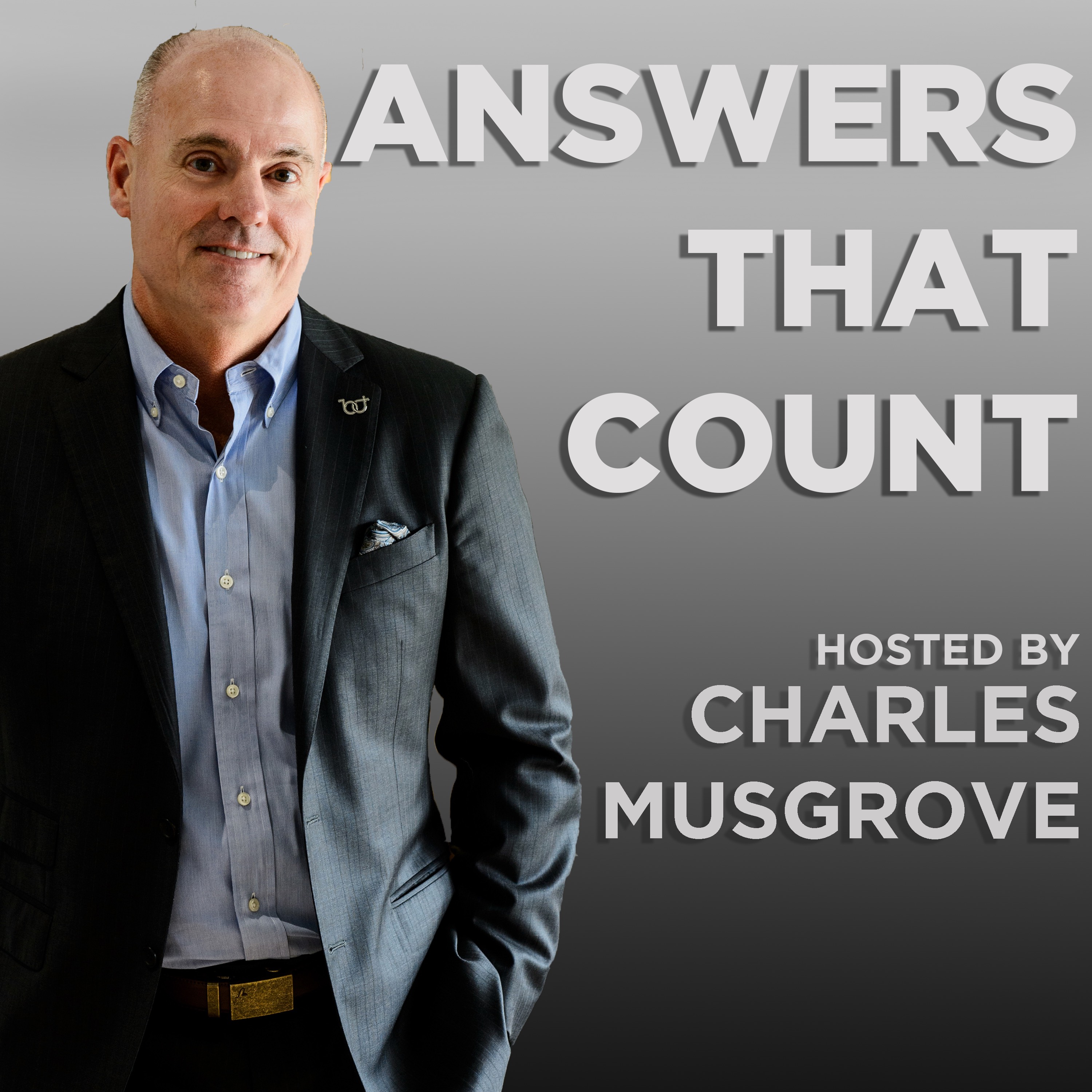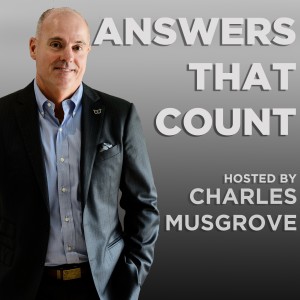
4.8K
Downloads
98
Episodes
Welcome to the gritty inside truth to running your Main Street Business! Learn what it takes to start, run, scale, protect, and yes make a profit in your business from one of the leading experts in business today. Charles Musgrove has guided countless Main Street Entrepreneurs through the pitfalls of running a profitable business. Now he shares this business insight through Answers That Count. Through his unique life experiences and entertaining interviews, you will discover the answers to the questions you have been asking!
Episodes

Tuesday May 12, 2020
Tuesday May 12, 2020
This session's guest is Van Carlson with Strategic Risk Alternatives (https://strategicriskalternatives.com/). Mr. Carlson has over twenty five years of experience within the risk management industry. Van began his career with Farmers Insurance Group as an agent; eventually growing his book to be among the largest in his home state of Idaho. Van specializes in advising clients how best to manage risk. The Captive Insurance company is a frequently used product he recommends for, implements and manages for his clients. This risk management tool is governed by 831(b) of the Internal Revenue Code.
A few take-aways from this session:
- The use of a Captive is a great tool to provide for protection of a businesses cash flow that may not be available though standard insurance policies.
- Coverage offered through the Captive is in addition to the standard insurance coverage that you would purchase to manage risk.
- The insurance premiums paid to the captive are tax deductible to the insured company, up to $2.2 million.
- The insurance premiums received by the captive are not taxable revenue up to $2.2 million per insured.
- A captive can be an optimal tool to provide business interruption coverage for events like the COVID-19 pandemic.
The Basics of the 831(b) Election for Captives
January 25, 2017
By P. Bruce Wright, M. Kristan Rizzolo, Saren Goldner, and Christopher W. Schoen
Sutherland Asbill & Brennan LLP
Section 831(b) was added to the Internal Revenue Code (IRC) in 1986 as part of an effort to more closely align the taxation of mutual and stock property and casualty ("P&C") insurance companies. Prior law provided for three layers of taxation for mutual P&C insurance companies depending on the quantum of their gross receipts but not for stock P&C insurance companies. Under section 831 as enacted in 1986, in general, both stock and mutual insurance companies that are not life insurance companies compute their tax as provided in IRC section 11, subject to the special rules for calculating taxable income that are contained in part II of subchapter L. In addition, the special rules that had applied to small mutual P&C insurance companies were extended to all small nonlife insurance companies.
Under section 831(b), small nonlife insurance companies that meet the requirements, including a premium limitations amount, may elect to be subject to an alternative tax based only on taxable investment income. Under this alternative tax, the underwriting profits of the electing insurance company are exempt from federal income tax.
In part as a result of perceived abuses, Congress changed the requirements for qualification under section 831(b) effective for taxable years ending after December 31, 2016, and at the same time increased the premium limitation amount. Section 831(b) now requires an electing company to
(1) be an insurance company;
(2) have net written premiums (or, if greater, direct written premiums) for the taxable year that do not exceed $2.2 million;1
(3) meet the diversification requirements described below; and
(4) make or have in effect, an election to be taxed under section 831(b).
The diversification requirements were added by Congress as anti-abuse measures to address estate and gift tax evasion issues; the amendments do not address federal income tax concerns. In general, to satisfy the diversification requirements, no one policyholder2 may pay more than 20 percent of a section 831(b) company's annual net written premiums (or, if greater, direct written premiums). For purposes of applying the 20 percent limitation, the amendments apply attribution rules under which all policyholders that are related within the meaning of sections 267(b) and 707(b), or are members of the same controlled group, are treated as a single policyholder. The new provisions also include an alternative diversification requirement that is an ownership-based test. Under the ownership test, the ownership of a section 831(b) company by "specified holders" (as defined below) must not be greater than (by more than a 2 percent de minimis margin) the ownership of the business or assets being insured. More specifically, an insurance company will have met this alternative diversification test if each specified holder that is an owner of the section 831(b) company has no greater interest in the section 831(b) company than he or she has in the insured business or assets (the "specified assets"). A specified holder is any individual who is a spouse or lineal descendant (including by adoption) of an individual who holds an interest (directly or indirectly) in the specified assets being insured.
In connection with amending the eligibility requirements for making an election to be subject to tax under section 831(b), Congress also added new annual information reporting requirements on electing companies, leaving the specifics of the required information up to the Internal Revenue Service (IRS).
In November 2016, shortly before the new provisions became effective for most electing companies, the IRS issued Notice 2016–66 indicating that certain section 831(b) companies are "transactions of interest" requiring information reporting under sections 6011 and 6111 as "reportable transactions." Notice 2016–66 provides that section 831(b) electing companies meeting the following requirements are "transactions of interest."
(1) A person ("A") directly or indirectly owns an interest in an entity (the "Insured") that conducts a trade or business;
(2) A, the Insured, or related person(s) directly or indirectly own at least 20 percent of the voting power or value of the section 831(b) electing company that contracts with Insured (or an intermediary) in a transaction that the section 831(b) electing company and the Insured treat as insurance or reinsurance of Insured; and
(3) Either
(a) section 831(b) electing company's incurred liabilities for losses and claims administration during the most recent 5 taxable years (or such shorter period if the company has been in existence only for such shorter period) are less than 70 percent of the company's premiums earned less policyholder dividends for the same period or,
(b.) during the same 5-year period, section 831(b) electing company has directly or indirectly made available or otherwise conveyed funds to A, the Insured or related person(s) in a transaction that did not result in taxable income or gain to the recipient of the funds.
Pursuant to Notice 2016–66, "material advisors" and all participants to the transactions are required to disclose information about the transactions to the IRS, including a description of the "insurance" coverage provided by the captive, the names and contact information of actuaries and underwriters, an explanation of how premium amounts were determined, a description of claims, and a description of the captive's assets. The initial report, for transactions from prior open years, originally was due January 30, 2017, but Notice 2017–08 extended the deadline for filing that initial report to May 1, 2017.
In February 2015, the IRS included section 831(b) companies on its "Dirty Dozen" list of tax scams. The IRS also has numerous audits of section 831(b) companies under way and cases docketed in the United States Tax Court. One of the concerns of the IRS is whether the transactions of section 831(b) electing companies are properly characterized as insurance. In order to be treated as insurance for federal tax purposes, a transaction must meet a four-part test that requires the presence of an insurance risk, risk shifting, and risk distribution and the recognition of the transaction as insurance in its commonly accepted sense (for more information on this topic, see "When Are Premiums Paid to a Captive Insurance Company Deductible for Federal Income Tax Purposes?").
P. Bruce Wright, M. Kristan Rizzolo, and Saren Goldner are partners and Christopher W. Schoen is counsel in the tax department of the law firm Sutherland Asbill & Brennan LLP. Mr. Wright and Ms. Goldner are located in New York, and Ms. Rizzolo and Mr. Schoen are located in Washington.
- The $2.2 million maximum is subject to increases for inflation, using 2013 as the base year for calculation.
- To date, there is not guidance on what is meant by a "policyholder," although Congress has proposed a technical corrections bill that would make it clear that a "policyholder" refers to the original direct insured.
The Benefits of Captive Insurance: Pros and Cons published by Alternative Risk Resources on their website
- Flexibility in setting the cost of premiums
- You may cover a huge variety of risks
- You have more control!
- They foster a greater safety culture
- You get ongoing education
- Risk management actually becomes profitable
Companies need to weigh the pros and cons of captive insurance to understand the potential benefit of insurance captives. Captive insurance allows your business to limit risk and retain what would have been insurance company profits. Unused premiums and income generated by your captive insurance company are returned to your business, turning what used to be an expense into a profit generating program.
Alternative Risk Resources’ group captive brokers make the process of understanding and joining a group captive insurance company a turnkey process.
Explaining the Basics of Group Captive Insurance
Access to underwriting profits and investment income are the most tangible benefits of joining a group captive program. The biggest benefit to joining, though, is the intangible safety culture captives foster.
Accidents and losses change from being something a business accepts will happen to avoidable events. Everybody in an organization insured through a captive becomes more safety conscious, changing the focus from minimizing claims to actively preventing accidents.
Long-term, proven cost savings and the increased profitability of group captive insurance programs make captives an attractive risk mitigation and investment solution for qualifying businesses. With a group captive, your company is in control of its insurance plan with underwriting profits and unused premiums returned as profit. A captive insurance program is a company providing insurance coverage and benefits exclusively to its member owners.
The businesses paying premiums are the same entities owning and profiting from the insurance company’s success.
Fewer claims and invested unused premiums translate directly into profit for the group captive’s member owners. The bottom line advantages over traditional insurance programs ensure that eventually every company qualifying for captive insurance will participate. The lack of knowledge about how group captive insurance programs work is often the only reason a qualified company is not a captive insured entity. Alternative Risk Resources’ professional brokers are here to help you understand the benefits of captive insurance.

No comments yet. Be the first to say something!